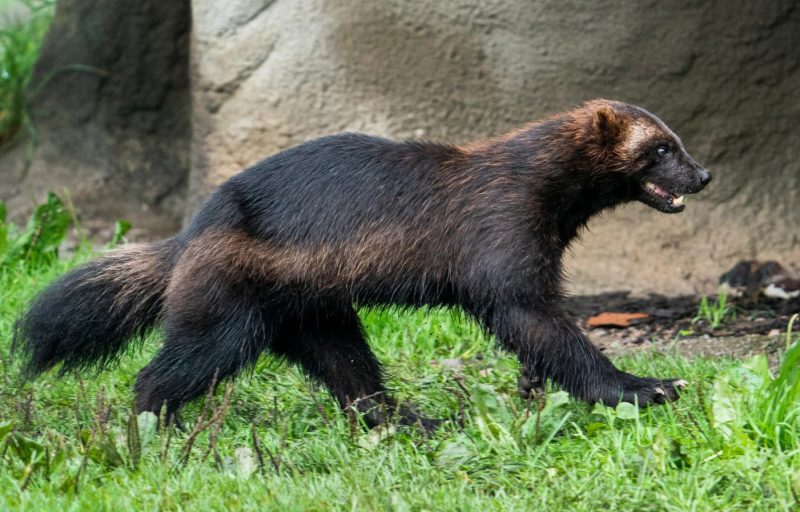Wolverines have long held a mythical status in North American wildlife lore. Fierce, elusive, and powerful, these solitary mammals evoke images of the untamed wilderness. Michigan, with its vast forests and rugged terrain, seems like a perfect habitat for wolverines. But the question remains: are there really wolverines in Michigan today? This article delves deeply into the evidence, the history, and the current status of wolverines in Michigan, separating fact from fiction and uncovering the truth behind their presence in the state.
For many, the idea of a wolverine roaming the dense northern woods of Michigan sparks excitement and curiosity. These animals are rarely seen, yet they have a profound cultural impact, symbolizing wilderness and resilience. But their elusiveness also means there is considerable mystery surrounding their existence in certain areas, especially in the Great Lakes region.
Understanding whether wolverines inhabit Michigan requires exploring multiple perspectives. Historical records suggest that wolverines once roamed widely across the state, but habitat changes, human expansion, and hunting pressures drastically reduced their populations. Scientific surveys, tracking studies, and citizen reports add layers of complexity to the story, sometimes offering contradictory signals. This article examines the available data, expert opinions, and recent sightings to provide a clear picture.
Beyond confirming their presence or absence, this exploration also sheds light on the challenges wolverines face in Michigan and similar regions. Habitat fragmentation, climate change, and human activities threaten their survival. At the same time, conservation efforts and increased awareness offer hope for their return. By understanding the truth about wolverines in Michigan, we better appreciate the delicate balance of wildlife ecosystems and our role in protecting them.
The Natural History of Wolverines in Michigan

Wolverines, scientifically known as Gulo gulo, are the largest members of the weasel family. They are known for their incredible strength, tenacity, and adaptability to cold, forested environments. Historically, wolverines were distributed across much of the northern United States, including Michigan. Their preferred habitats include boreal forests, dense brush, and rugged, snowy regions where they can hunt, scavenge, and den.
In Michigan, the wolverine’s range primarily covered the Upper Peninsula and parts of the northern Lower Peninsula. The region’s mix of coniferous forests, wetlands, and rugged terrain provided ample cover and food sources such as small mammals, carrion, and occasional larger prey.
Historical accounts from the 19th and early 20th centuries confirm wolverine presence in Michigan. Trappers and hunters occasionally reported catching or seeing wolverines, and Indigenous peoples had long known of the species, often including it in their folklore and stories.
However, as European settlement expanded, wolverines faced intense pressures. Logging transformed the landscape, removing old-growth forests essential for wolverine denning and hunting. The rise of agriculture and human habitation further fragmented habitats. Additionally, wolverines were sometimes hunted or trapped for their fur or because they were considered threats to livestock.
By the mid-20th century, wolverines had all but disappeared from Michigan. Their population declined sharply, leading many experts to classify them as extirpated (locally extinct) in the state. For decades, no confirmed sightings were reported, and the idea of wolverines living in Michigan became more folklore than fact.
Modern Evidence and Scientific Research
Despite the long absence, reports of wolverine sightings in Michigan have sporadically emerged in recent decades, reigniting interest and debate. These reports come from hunters, hikers, wildlife photographers, and residents who claim to have seen or encountered wolverines or signs of their presence such as tracks or scat.
The scientific community has approached these claims with cautious skepticism. Wolverines are notoriously difficult to detect due to their low densities and secretive nature. To address this, wildlife biologists have employed various research methods to survey for wolverines in Michigan and surrounding regions.
Camera traps, which use motion sensors to photograph passing wildlife, have been placed in areas thought to be suitable wolverine habitat. Although these cameras have captured many species, confirmed wolverine images remain elusive or unverified. Similarly, DNA analysis from hair snares and scat samples has been used to detect the presence of elusive carnivores. While these methods have been successful in other parts of North America, evidence for wolverines in Michigan remains scarce.
The lack of definitive scientific proof has led some experts to conclude that if wolverines do exist in Michigan, their populations are either extremely small, transient, or composed of individuals wandering in from neighboring states or Canada. Wolverines have been documented in the northern Rockies, the Great Lakes region of Ontario, and other northern areas, so occasional dispersal into Michigan is possible.
Possible Reasons for Their Elusiveness
Several factors contribute to why wolverines are so rarely seen or confirmed in Michigan. Firstly, wolverines have large home ranges, often covering tens or even hundreds of square miles. This extensive roaming behavior reduces the chances of human encounters.
Secondly, their preference for remote, rugged terrain means they avoid populated or easily accessible areas. Michigan’s northern wilderness areas offer such habitat, but much of it remains challenging to survey thoroughly.
Thirdly, wolverines are solitary and primarily nocturnal, further decreasing the likelihood of observation. Their cryptic coloration blends with forest shadows, making visual detection difficult.
Additionally, the low density of wolverines — if any remain in Michigan — means even well-placed cameras or tracking efforts might not capture evidence. The species’ sensitivity to disturbance also means that human presence can push them into more secluded areas.
Lastly, misidentification can cloud reports. Other animals such as fishers, coyotes, or large weasels can sometimes be mistaken for wolverines, leading to false positives in anecdotal sightings.
Wolverines’ Ecological Role and Importance
Wolverines play a crucial ecological role as both predators and scavengers. Their presence helps regulate prey populations, clean up carrion, and maintain healthy forest ecosystems. Their ability to survive in harsh conditions and cover vast areas also makes them indicators of wilderness health.
In Michigan, if wolverines still roam, they would contribute to the biodiversity and ecological balance of the northern forests. Protecting their habitat benefits not only wolverines but many other species that share the same environment.
The loss or absence of apex predators and scavengers like wolverines can disrupt food webs and lead to overpopulation of certain species, habitat degradation, and reduced ecosystem resilience. Therefore, understanding and preserving wolverine populations, even if small or recovering, is vital.
Conservation Efforts and Challenges in Michigan
Conservationists face many challenges when working to protect or restore wolverines in Michigan. Habitat fragmentation due to logging, road building, and urban expansion limits the availability of large, contiguous wilderness areas necessary for their survival.
Climate change poses additional risks. Wolverines rely on deep snowpacks for denning and raising young, conditions that are threatened by rising temperatures and altered precipitation patterns. Reduced snow cover could force wolverines to shift ranges or face increased mortality.
Efforts to conserve wolverines must therefore focus on protecting and restoring suitable habitats, reducing human-wildlife conflicts, and enhancing connectivity between wilderness areas to facilitate gene flow.
In Michigan, conservation groups collaborate with state wildlife agencies, researchers, and local communities to raise awareness and monitor potential wolverine habitats. Though the evidence for current populations is limited, proactive measures aim to prepare for potential recolonization or reintroduction.
Federal and state laws protect many wildlife species and their habitats, and initiatives such as habitat conservation plans help balance development with ecological preservation. Public education also plays a key role in reducing misconceptions and encouraging coexistence.
Cultural Significance and Public Perception
Wolverines hold a unique place in Michigan’s cultural and natural history. They embody the spirit of the wild—strong, independent, and elusive. Native American stories often feature wolverines as tricksters or symbols of resilience.
The mystery surrounding their existence in Michigan has fueled folklore, local legends, and a passionate following among wildlife enthusiasts. The idea of spotting a wolverine excites many people, inspiring outdoor exploration and wildlife photography.
However, this mystique can also lead to unrealistic expectations or confusion with other wildlife. Managing public perception involves balancing enthusiasm with scientific understanding, emphasizing respect for wildlife and the realities of conservation.
The Truth Revealed: Are Wolverines Really in Michigan?
After reviewing historical records, scientific research, and recent reports, the truth about wolverines in Michigan remains nuanced. While there is no conclusive evidence of a stable, breeding population of wolverines currently living in the state, occasional transient individuals may pass through, especially from nearby regions in Canada or northern states.
Their extreme rarity and elusive nature mean that if wolverines do exist in Michigan, they do so in very small numbers, possibly as dispersing juveniles or temporary visitors. Scientists continue monitoring and studying suitable habitats to detect any signs of a resurgence.
The possibility of reintroduction programs is also a subject of discussion, though such efforts require careful planning, habitat assessment, and community support.
In essence, while wolverines have deep roots in Michigan’s ecological and cultural past, their present status is more of a question mark than a definitive fact. The search for wolverines continues, embodying the spirit of wilderness conservation and discovery.
What the Future Holds for Wolverines in Michigan
Looking forward, the future of wolverines in Michigan depends on multiple factors including habitat protection, climate trends, and human cooperation. Expanding wilderness areas, preserving connectivity between habitats, and mitigating climate impacts are critical.
Scientific advances in wildlife monitoring such as environmental DNA (eDNA) sampling, more sensitive camera traps, and tracking technology will improve detection and understanding of wolverine presence.
Public interest and support will remain essential to drive funding, conservation policies, and coexistence strategies. As awareness grows, communities may become active partners in protecting wilderness corridors and advocating for wolverine-friendly practices.
Moreover, regional collaboration across state and international borders can enhance conservation outcomes, recognizing that wildlife populations do not adhere to human boundaries.
Ultimately, the story of wolverines in Michigan is not just about a single species but reflects the broader challenges and hopes of preserving wild places and the creatures that inhabit them.
FAQs About Wolverines in Michigan
Are wolverines native to Michigan?
Yes, wolverines historically ranged across Michigan, especially in the Upper Peninsula and northern Lower Peninsula, but they were extirpated by the mid-20th century.
Have there been recent confirmed sightings of wolverines in Michigan?
No confirmed scientific evidence currently supports stable populations, but some unverified reports and possible transient individuals have been noted.
What kind of habitat do wolverines need?
Wolverines prefer remote, forested, and snowy regions with large territories for hunting and denning.
Could wolverines naturally recolonize Michigan?
It’s possible that dispersing wolverines from Canada or northern states could enter Michigan, but establishing a breeding population would require suitable habitat and protection.
What threats do wolverines face in Michigan?
Habitat fragmentation, climate change affecting snow cover, human disturbance, and potential conflicts pose challenges to wolverine survival.






